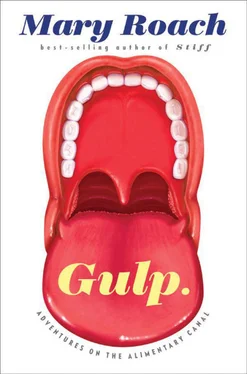While she is out, I will take this opportunity to share with you the extremely surprising findings on the topic of olfactory stimulation of saliva. The notion that food smells make your mouth water is, science says, erroneous. Science has said this over and over, most recently in 1991, at King’s College London. Ten subjects donned plastic odor-delivering face masks and nickel-sized Lashley cups. (The Lashley cup, a sort of glandular beret, fits on top of the parotid and collects its secretions.) Food odors wafted into the volunteers’ noses: vanilla, chocolate, peppermint, tomato, and beef. Only one smell, and in only one subject, caused a significant increase in salivation. Oddly, this subject was a vegetarian, and she was smelling beef. Upon questioning, the woman revealed that the smell had nauseated her. The salivation was the kind that precedes throwing up.
It is easy to criticize that study. Sitting in a lab with a plastic mask on your face and sniffing chemically synthesized odorants does not approximate the typical mealtime mouth-watering scenario. This does, though. In 1960, a bright-eyed, full-lipped young physiologist named Alexander Kerr fried up bacon and eggs in his lab at Harvard. He did so in front of three hungry volunteers, whose parotid flow was measured via a type II outflow recorder [40] Less high-tech than it sounds. Subjects leaned over and spat into the machine every two minutes. A slight improvement over the earliest collection technique, circa 1935: “The subject sits with head tilted forward, allowing the saliva to run to the front of the mouth… and drip out between parted lips.” A photo in Kerr’s monograph shows a nicely dressed woman, hair bobbed, hands palm down on the table in front of her, forehead resting in a support. An enamel basin is positioned just so, to catch the drippings.
—the Lashley cup having not yet been invented. Even here, no one salivated any more than he had before the cooking began. The subject identified as A.G. didn’t buy it. A.G. was positive he could feel his mouth “watering profusely” in the moments before he began eating. Kerr insisted that wasn’t so. He told A.G. that the feeling was an artifact caused by shifting his attention to the inside of his mouth and suddenly becoming “conscious that his mouth contains saliva.” I have seen the data, but I too find it hard to believe Dr. Kerr.
IT’S BEEN SNOWING all morning. Wet clumps of flakes flock the trunks and branches of the trees outside the lab. Silletti joins me at the window. She holds the small glass beakers that contain our fresh-from-the-centrifuge stimulated samples.
“It’s beautiful,” I am saying. Silletti agrees, but I notice she isn’t looking out the window. Is it possible she thinks I am referring to the contents of the beakers? I’d say that, yes, it is possible. You’ve never seen such clear, clean-looking spit. Stimulated saliva looks, tastes, and flows like water—it is, in fact, 99 percent water. Water with some proteins and minerals. Like water from different springs, each person’s saliva contains minerals in unique proportions. (People whose saliva naturally contains a lot of salt are slightly oblivious to it in their food.)
“So somebody,” I observe, “could do a taste test with various salivas.”
“If somebody would like to do that, yes.”
Somebody—really everybody—wouldn’t. I point to the beaker labeled E . “What about just your own? Would you ever—”
“No, I wouldn’t. Even me. Although actually, you are drinking it all the time.”
“Right, so—”
“ No .”
An intriguing double standard applies to your own saliva. As long as it stays in your mouth, it’s benign, welcomed even, no more offensive than the water it tastes like. Outside your mouth, it’s almost as vile and contemptible as a stranger’s. As part of a study, our friend from the University of Pennsylvania psychology department, Paul Rozin, asked subjects to imagine a bowl of their favorite soup and to rate their liking of it. He then asked them to rate that same bowl of soup after they’d imagined spitting into it. Forty-nine out of fifty subjects lowered their rating. Among certain castes in India, writes Edward Harper in “Ritual Pollution as an Integrator of Caste and Religion,” spitting on someone puts even the spitter “in a state of severe impurity,” because it is assumed that some of his saliva has “rebounded onto him.”
The saliva taboo can make life burdensome for researchers. Silletti’s colleague René de Wijk did a study years ago that looked at how the salivary breakdown of starch mobilizes fats and enhances flavor. (Fat is the main carrier of flavor.) To do this study, he needed his subjects to rate the taste of custard samples with and without a drop of their saliva added. You can’t just have them spit in it, he explained, because then they won’t go near it. He had to collect samples of their saliva without telling them why, and then add it behind their backs, like a spiteful waitress.
The same double standard applies to all “body products,” as Rozin calls them, managing to make snot and saliva sound like spa purchases. We are large, mobile vessels of the very substances we find most repulsive. Provided they stay within the boundaries of the self, we feel no disgust. They’re part of the whole, the thing we cherish most.
Paul Rozin has given a lot of thought to what he calls the psychological microanatomy of the mouth: Where, precisely, is the boundary between self and nonself? If you stick your tongue out of your mouth while eating and then withdraw it, does the ensalivated food now disgust you? It does not. The border of the self extends the distance of the tongue’s reach. The lips too are considered an extension of the mouth’s interior, and thus are part of the self. Though culture shifts the boundaries. Among religious Brahmin Indians, writes Edward Harper, even the saliva on one’s own lips is considered “extremely defiling,” [41] But nothing compared to crow droppings. According to Harper, the traditional purification ritual for the Brahmin polluted by crow feces is “a thousand and one baths.” This has been rendered less onerous by the invention of the showerhead and the crafty religious loophole. “The water coming through each hole counts as a separate bath.”
to the extent that if one “inadvertently touches his fingers to his lips, he should bathe or at the least change his clothes.”
The boundaries of the self are routinely extended to include the bodily substances of those we love. I’m going to let Rozin say this: “Saliva and vaginal secretions or semen can achieve positive value among lovers, and some parents do not find their young children’s body products disgusting.”
I recall being told, in grade school, that Eskimos kiss by rubbing noses. Is this an example of a culture reluctant to accept the saliva of a loved one? Gabriel Nirlungayuk, my go-to man for all things Eskimo/Inuit, confirmed that the kunik , or nose rub, has been and remains the traditional alternative to the kiss. “Even to this day, now that my children are adults, I kunik them when I have been away for a long time.” But never girlfriends. By the time Nirlungayuk was a teenager, kissing “whiteman’s way” had caught on. Nobody seemed to have a problem with extending those boundaries. If anything, the Inuit are leaders in the field. “Sometimes when my ingutaq— granddaughter—is full of snot, my wife or myself will wipe it clean with our mouths and then spit it out. But we would never consider this with other kids.”
A similar psychology applies to breast milk. It’s considered natural for a child to consume a mother’s milk, or even for a lover to do so, but not a stranger. (Hence the 2010 hullaballoo over the New York City restaurateur who invited diners to try cheese made from his wife’s breast milk.) So reliable is breast-milk consumption as a delimiter of intimate family that Islam recognizes a category called “breast milk son,” which confers an exemption to the rules on segregation of the sexes. A man can be alone with a woman if she’s immediate family or if she breast-fed him as a child. [42] Or, as of 2007, an adult. Egyptian scholar Ezzat Attiya issued a fatwa, or religious opinion, extending breast-milk-son status to anyone a woman has “symbolically breastfed.” For convenience’s sake, drivers and deliverymen could, by drinking five glasses of a woman’s breast milk, be permitted to spend time alone with her. In the ensuing ruckus, another scholar insisted the man would have to drink directly from the woman’s breast. Which is crazier: that Saudi courts, in 2009, sentenced a woman to forty lashes and four months in prison for allowing a bread deliveryman inside her home, or the notion that she might have avoided punishment by letting him suckle from her breast? The woman was seventy-five, if that helps you with your answer.
(Sisters sometimes breast-feed each other’s infants, thereby creating breast-milk relatives.) Milk is thicker than blood, or about the same consistency.
Читать дальше












